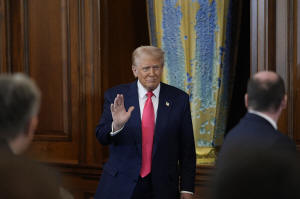Trump vows to take back 'stolen' wealth as tariffs on steel and aluminum
imports go into effect
[March 13, 2025]
By JOSH BOAK, PAUL WISEMAN and ROB GILLIES
WASHINGTON (AP) — President Donald Trump openly challenged U.S. allies
on Wednesday by increasing tariffs on all steel and aluminum imports to
25% as he vowed to take back wealth “stolen” by other countries, drawing
quick retaliation from Europe and Canada.
The Republican president's use of tariffs to extract concessions from
other nations points toward a possibly destructive trade war and a stark
change in America’s approach to global leadership. It also has
destabilized the stock market and stoked anxiety about an economic
downturn.
“The United States of America is going to take back a lot of what was
stolen from it by other countries and, frankly, by incompetent U.S.
leadership,” Trump told reporters on Wednesday. “We’re going to take
back our wealth, and we’re going to take back a lot of the companies
that left.”
Trump removed all exemptions from his 2018 tariffs on the metals, in
addition to increasing the tariffs on aluminum from 10%. His moves,
based off a February directive, are part of a broader effort to disrupt
and transform global commerce.
He has separate tariffs on Canada, Mexico and China, with plans to also
tax imports from the European Union, Brazil and South Korea by charging
“reciprocal” rates starting on April 2.
The EU announced its own countermeasures on Wednesday. European
Commission President Ursula von der Leyen said that as the United States
was “applying tariffs worth 28 billion dollars, we are responding with
countermeasures worth 26 billion euros,” or about $28 billion. Those
measures, which cover not just steel and aluminum products but also
textiles, home appliances and agricultural goods, are due to take effect
on April 1.

U.S. Trade Representative Jamieson Greer responded by saying that the EU
was punishing America instead of fixing what he viewed as excess
capacity in steel and aluminum production.
“The EU’s punitive action completely disregards the national security
imperatives of the United States – and indeed international security –
and is yet another indicator that the EU’s trade and economic policies
are out of step with reality,” he said in a statement.
Meeting on Wednesday with Ireland’s Taoiseach Micheál Martin, Trump said
“of course” he wants to respond to EU's retaliations and “of course”
Ireland is taking advantage of the United States.
“The EU was set up in order to take advantage of the United States,”
Trump said.
Last year, the United States ran a $87 billion trade imbalance with
Ireland. That's partially because of the tax structure created by
Trump’s 2017 overhaul, which incentivized U.S. pharmaceutical companies
to record their sales abroad, Brad Setser, a senior fellow at the
Council of Foreign Relations, said on X.
Canada sees itself as locked in a trade war because of White House
claims about fentanyl smuggling and that its natural resources and
factories subtract from the U.S. economy instead of supporting it.
“This is going to be a day to day fight. This is now the second round of
unjustified tariffs leveled against Canada,” said Mélanie Joly, Canada's
foreign affairs minister. “The latest excuse is national security
despite the fact that Canada’s steel and aluminum adds to America’s
security. All the while there is a threat of further and broader tariffs
on April 2 still looming. The excuse for those tariffs shifts every
day.”
Canada is the largest foreign supplier of steel and aluminum to the
United States and plans to impose retaliatory tariffs of Canadian $29.8
billion ($20.7 billion) starting Thursday in response to the U.S. taxes
on the metals.
Canada's new tariffs would be on steel and aluminum products, as well as
U.S. goods including computers, sports equipment and water heaters worth
$14.2 billion Canadian ($9.9 billion). That's in addition to the 25%
counter tariffs on $30 billion Canadian (US$20.8 billion) of imports
from the U.S. that were put in place on March 4 in response to other
Trump import taxes that he’s partially delayed by a month.
Trump told CEOs in the Business Roundtable a day earlier that the
tariffs were causing companies to invest in U.S. factories. The 7.5%
drop in the S&P 500 stock index over the past month on fears of
deteriorating growth appears unlikely to dissuade him, as Trump argued
that higher tariff rates would be more effective at bringing back
factories.
[to top of second column] |

President Donald Trump arrives at the annual St. Patrick's Day
luncheon at the Capitol in Washington, Wednesday, March 12, 2025.
(AP Photo/J. Scott Applewhite)
 “The higher it goes, the more likely
it is they’re going to build,” Trump told the group. “The biggest
win is if they move into our country and produce jobs. That’s a
bigger win than the tariffs themselves, but the tariffs are going to
be throwing off a lot of money to this country.”
Trump on Tuesday had threatened to put tariffs of 50% on steel and
aluminum from Canada, but he chose to stay with the 25% rate after
the province of Ontario suspended plans to put a surcharge on
electricity sold to Michigan, Minnesota and New York.
Democratic lawmakers dismissed Trump's claims that his tariffs are
about national security and drug smuggling, saying they're actually
about generating revenues to help cover the cost of his planned
income tax cuts for the wealthy.
“Donald Trump knows his policies could wreck the economy, but he’s
doing it anyway,” said Senate Democratic Leader Chuck Schumer of New
York. “Why are they doing all these crazy things that Americans
don’t like? One reason, and one reason alone: tax breaks for
billionaires, the north star of the Republican party’s goals.
In many ways, the president is addressing what he perceives as
unfinished business from his first term. Trump meaningfully
increased tariffs, but the revenues collected by the federal
government were too small to significantly increase overall
inflationary pressures.
Outside forecasts by the Budget Lab at Yale University, Tax Policy
Center and others suggest that U.S. families would have the costs of
the taxes passed onto them in the form of higher prices.
With Wednesday's tariffs on steel and aluminum, Trump is seeking to
remedy his original 2018 import taxes that were eroded by
exemptions.
After Canada and Mexico agreed to his demand for a revamped North
American trade deal in 2020, they avoided the import taxes on the
metals. Other U.S. trading partners had import quotas supplant the
tariffs. And the first Trump administration also allowed U.S.
companies to request exemptions from the tariffs if, for instance,
they couldn’t find the steel they needed from domestic producers.
While Trump's tariffs could help steel and aluminum plants in the
United States, they could raise prices for the manufacturers that
use the metals as raw materials.
Moreover, economists have found, the gains to the steel and aluminum
industries were more than offset by the cost they imposed on
“downstream’’ manufacturers that use their products.

At these downstream companies, production fell by nearly $3.5
billion because of the tariffs in 2021, a loss that exceeded the
$2.3 billion uptick in production that year by aluminum producers
and steelmakers, the U.S. International Trade Commission found in
2023.
Trump sees the tariffs as leading to more domestic factories, and
the White House has noted that Volvo, Volkswagen and Honda are all
exploring an increase to their U.S. footprint. But the prospect of
higher prices, fewer sales and lower profits might cause some
companies to refrain from investing in new facilities.
“If you’re an executive in the boardroom, are you really going to
tell your board it’s the time to expand that assembly line?” said
John Murphy, senior vice president at the U.S. Chamber of Commerce.
The top steel exporters to the U.S. are Canada, Mexico, Brazil,
South Korea and Japan, with exports from Taiwan and Vietnam growing
at a fast pace, according to the International Trade Administration.
Imports from China, the world's largest steel producer, account for
only a small fraction of what the U.S. buys.
The lion's share of U.S. aluminum imports comes from Canada.
All contents © copyright 2025 Associated Press. All rights reserved |